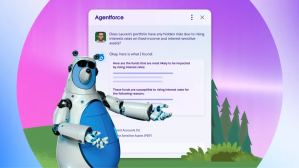Salesforce Checkout increases buyer conversion with a universal checkout experience that connects to all customer touchpoints on the Einstein 1 Platform
Headless commerce capabilities for B2B help developers build and scale B2B sites quickly to keep pace with shifting markets
Composable commerce enhancements for B2C allows developers to quickly assemble customized commerce experiences to meet the specific needs of consumers
Salesforce today introduced three new Commerce Cloud innovations to help businesses build commerce sites that can boost revenue while delivering personalized customer experiences. These improved development and checkout capabilities will help merchants address growing customer expectations for a seamless, integrated experience across all channels.
Why it matters: With 32% of customers stating they will abandon a brand after one poor experience, the importance of acquiring and retaining digital commerce customers is at an all-time high. As such, many business-to-business (B2B) and business-to-consumer (B2C) companies are looking for ways to deliver more consistent, connected, and data-driven ecommerce experiences to chronic retail challenges like shopping cart abandonment and shrinking customer loyalty.
Go deeper: Salesforce’s new site development and checkout features include:
- Salesforce Checkout: A unified, one-click checkout platform connected to customer data, Salesforce Checkout is built on the Einstein 1 Platform to provide shoppers with more consistent, cross-channel experiences throughout their buying journeys — no matter where they engage with a brand. Salesforce Checkout also has built-in merchant services for payments, tax, and shipping, cutting lengthy integrations and hefty vendor bills. Stripe now powers these native tax services as part of its expanded partnership with Salesforce Commerce Cloud.
- A customer, for example, can purchase an air conditioner from an HVAC company’s website on their computer. While a field agent is installing it in the building, the customer can pull up their mobile phone and conveniently pay for the installation with a single click, using the same checkout experience with their stored preferred payment method – all on the same site.
- Headless commerce capabilities for B2B: Developers can implement headless commerce with out-of-the-box APIs in Commerce Cloud that help merchants create engaging B2B sites that rival traditional consumer shopping experiences. The framework can be customized to fit the needs of businesses and includes access to both Salesforce platform APIs and commerce-specific APIs. B2B commerce companies can also integrate with hundreds of apps developed by the Salesforce partner ecosystem on AppExchange, to build and scale headless commerce projects in record time with less complexity.
- For example, a manufacturer that traditionally makes and processes sales through an internal portal that’s only available to its reps could quickly build a customer-facing storefront during its peak order season that allows buyers to place small or one-time orders on their own. This can increase efficiency and decrease the workload of reps who are handling more complex orders.
- Composable Commerce Enhancements for B2C: Developers can combine or create templated, composable, and customizable headless approaches to B2C ecommerce site development with new powerful Salesforce APIs and out-of-the-box personalization functionality. The ready-to-implement personalization features — such as Product Listing Page (PLP) tiles, site map generation, store locator, and Buy Online Pickup in Store — reduce development time and can also be customized to meet every business’ needs. Customers can leverage SI partners within Commerce Cloud’s trusted partner ecosystem to help build these hybrid commerce experiences quickly and at scale.
- For example, by using the new integrated personalization features for composable commerce, a merchant at a women’s apparel brand can pivot and capitalize on a flash fashion trend – without disrupting operations – by creating new PLPs that feature apparel and product descriptions related to the trend.
Salesforce perspective: “Commerce companies are looking to architect high-caliber ecommerce sites that can swiftly adapt to changing customer expectations and continue to foster strong customer relationships. With the combined power of data, AI, and CRM, Commerce Cloud gives brands the choice of the right tool so they can build superior shopping experiences their way.” – Michael Affronti, GM and SVP of Commerce Cloud
With the combined power of data, AI, and CRM, Commerce Cloud gives brands the choice of the right tool so they can build superior shopping experiences their way.”
Michael Affronti, GM and SVP of Commerce Cloud
Availability:
- Salesforce Checkout, Headless B2B Commerce, and Composable Commerce for B2C will all be generally available this summer.
More information:
- Watch Connections 2024 on Salesforce+
- Learn more about Commerce Cloud
- Get the latest State of Commerce research
- Find out more about headless commerce and its growing popularity
Any unreleased services or features referenced here are not currently available and may not be delivered on time or at all. Customers should make their purchase decisions based upon features that are currently available.















